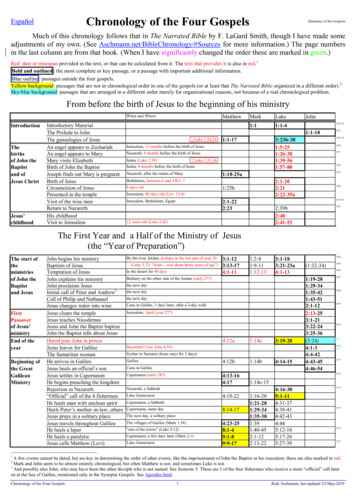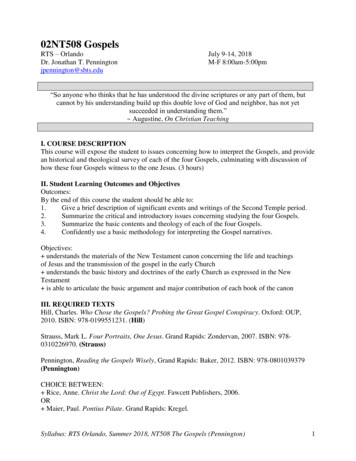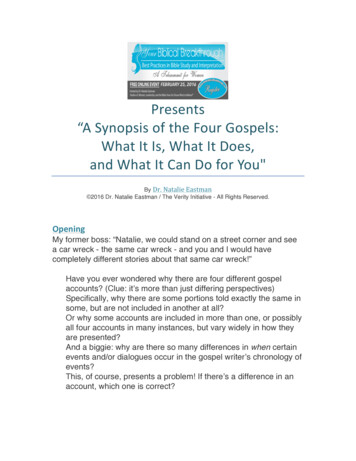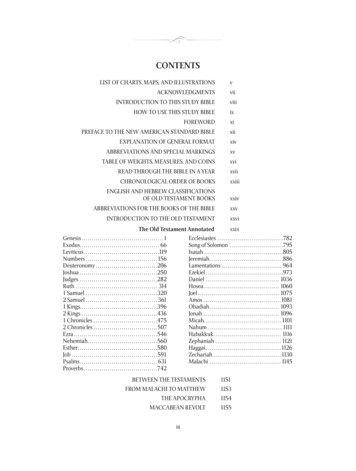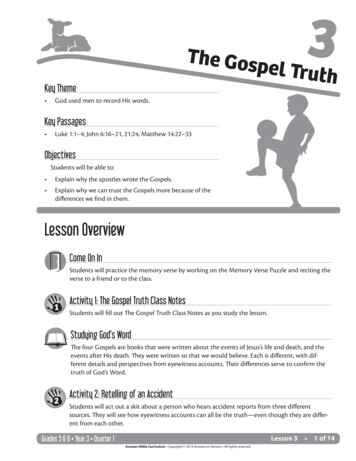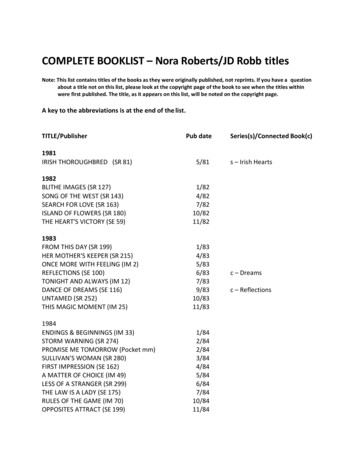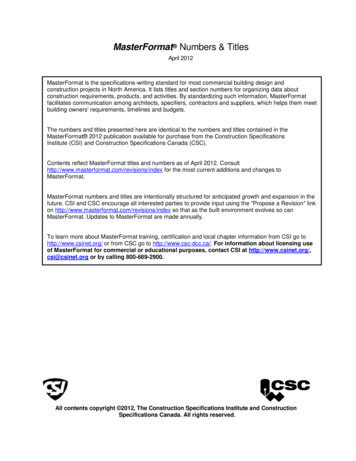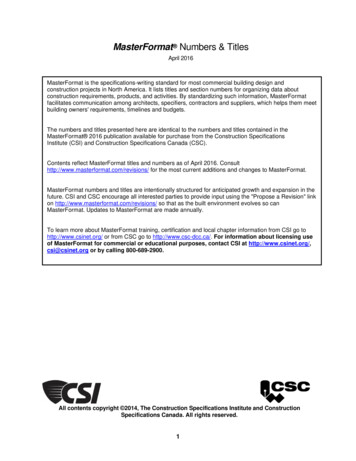
Transcription
The Titles of the Gospels inthe Earliest New Testament ManuscriptsSimon J. Gathercole(Faculty of Divinity, West Road, Cambridge, CB3 9BS, UK; sjg1007@cam.ac.uk)ProlegomenaThe 27th Nestle-Aland hand edition of the New Testament is without doubtan extraordinary achievement, as are its many predecessors. As has sometimesbeen remarked, however, it does have certain flaws, and it is the purpose of thepresent article to identify and attempt to rectify one of these flaws. It is unfair,however, to single out Nestle-Aland, as the problem under discussion here isshared with other NT hand editions, such as the UBS and SBL texts.1 The issue to be addressed in this article is that of the presentation of the titles of thefour gospels in the main text of the Novum Testamentum Graece as well as in itsapparatus criticus. See also the Additional Note on NA28.The Nestle-Aland TitlesThe problems with the presentation of titles in Nestle-Aland boil down to six,sometimes overlapping, elements.First, information provided about gospel titles in NA27 is confined to theopening titles. Modern readers of course expect that a title will be provided atthe beginning of a work, but this was not necessarily true in antiquity. Ancientbook titles often appeared at the end of a text. Having discussed the placementof titles in rolls, Schubart notes in re early codices: ‘Wie dort [sc. in the roll],steht auch hier [sc. in the codex] der Hauptitel am Ende des Textes ’.2 Thesituation is actually more complicated than Schubart suggests3, but, all thesame, end-titles are very significant, and at least just as common, probablyeven more common than opening titles. In her study of rolls and codices of1 The Greek New Testament, London 41993; M.W. Holmes (ed.), The Greek New Testament: SBL Edition, Atlanta/ Bellingham 2010.2 W. Schubart, Das Buch bei den Griechen und Römern, Berlin/Leipzig 1921, 139.3 See C. Wendel, Die griechisch-römische Buchbeschreibung verglichen mit der des Vorderen Orients, Halle 1949, 27, discusses a passage in Dio Chrysostom about authors writing their names both at the beginning and at the end of a work (Or. 53,9–10) and anotherin Augustine who reports that he did not see the title of Jerome’s work at the beginning ofthe codex ut adsolet (Ep. 40,2 [CSEL 34,71]). This passage of course attests to both whatAugustine was familiar with, but also the opposite.ZNW 104. Bd., S. 33–76 Walter de Gruyter 2013DOI 10.1515/znw-2013-0002Brought to you by Fordham University LibraryAuthenticated 150.108.161.71Download Date 2/19/13 8:02 AM
34Simon J. Gathercoleepic poetry, Schironi poses the question: ‘Why are end-titles far more common than beginning-titles?’4 In NA27 copious information is provided aboutsubscript titles and colophons to the Pauline letters with Hebrews, but there isno information in the apparatus about any of the subscriptions to the gospels(or other NT books).5 More understandable is the lack of reference to othertitles, such as running headers, which have been little studied.6 There are infact a number of locations in which titles may appear: (i) on a flyleaf, i.e. ona page of its own; (ii) an opening title above or at the beginning of the text ofthe particular gospel; (iii) in a list of the contents of a codex, or in the title ofa kephalaia or capitula list, or in the title of an argumentum; (iv) as a runningtitle, at the top of a page (or across an opening) more or less consistentlythrough a manuscript of a gospel; (v) as a subscriptio at the end of a gospel:this too might be subdivided into the end-title tout simple, and those titleswhich appear in longer colophons (see e.g. on Codex Bezae below). This clarification of terminology is important, in particular because (ii), (iii) and (iv)are sometimes lumped together under the heading of superscriptiones or inscriptiones (superscriptions/ Überschriften), even though their position in themanuscript often dictates a different form of the title:7 where a manuscript hasan introductory title in the longer form (e.g. ευαγγελιον κατα μαθθαιον),for example, the running header may still appear in the shorter form (e.g. καταμαθθαιον), as in Codex Bezae. Henceforth, the word “title” will be used indiscriminately to refer to any of the above, whereas if a particular location is inview, this will be specified.A second, and related question is that of how the inscriptiones in NA27 arereconstructed or identified. Leaving aside mistakes about particular readingsin manuscripts, there is one instance of a problematic method, namely whereevidence for an opening title is derived from a subscript title: in NA27’s “VariaeLectiones Minores” (Appendix 2), it is noted that the reading ευαγγελιονκατα ιωαννην is assigned to “(A)” in parenthesis because the inscriptio hasbeen reconstructed or transferred “e subscriptione”.8 This practice of reconstructing the opening title with a post-script title may not be legitimate (because the form of a title can vary according to its placement), nor is this practice carried out consistently.4 F. Schironi, ΤΟ ΜΕΓΑ ΒΙΒΛΙΟΝ: Book-ends, End-titles, and Coronides in Papyri withHexametric Poetry, Durham, NC 2010, 83 (cf. 21.39 n. 97.80.82). Complementary toSchironi’s study of end-titles is M. Caroli, Il titolo iniziale nel rotolo librario greco-egizio:Con un catalogo delle testimonianze iconografiche greche e di area vesuviana, Bari 2007,although this is confined to rolls. On Coptic titles, see P. Buzi, Titoli e autori nella tradizione copta, Pisa 2005.5 Some reference is made in the appendix to NA27, as we will see below.6 The best coverage of running headers in early manuscripts is in D.C. Parker, Codex Bezae: An Early Christian Manuscript and its Text, Cambridge 1992, 10–22.7 See e.g. the use of inscriptio for both opening and running titles in C. Tischendorf, CodexEphraemi Syri Rescriptus, Leipzig 1843, 11*.8 Novum Testamentum Graece, Stuttgart 27.51998, 732.Brought to you by Fordham University LibraryAuthenticated 150.108.161.71Download Date 2/19/13 8:02 AM
The Titles of the Gospels in the Earliest New Testament Manuscripts35Thirdly, another matter which relates to the appendix of the variae lectiones minores is a small inconsistency in how different hands are treated in theNA27 apparatus. One can compare here the presentation of the inscriptio ofJohn’s gospel. The evidence from Washingtoniensis is given as ‘Ws’ and that ofSinaiticus and Vaticanus as ‘(ℵ B)’. The parenthesis calls for consultation ofAppendix 2, which indicates writing ‘secunda manu’. Most readers will takeall this to mean that the W evidence is solid, but that of ℵ and B less secure:they are after all placed in brackets and indicated as coming from a secondhand. In fact the opposite is the case, although one cannot really find thisout from Nestle-Aland alone. As we shall see, the “second hand” in ℵ is partof the original scriptorium, and the same is probably true of B, whereas Wspostdates the original writing of Washingtonianus perhaps by three or fourcenturies. The present article will attempt to remedy such complex mattersby presenting the data about the hands in as rational a manner as possiblewithout compromising clarity.Fourthly, each inscriptio is printed in the form ⸂ ΚΑΤΑ ΜΑΘΘΑΙΟΝ ⸃etc. This placement of half-parentheses around the title may have the effect ofleading unwary students, many of whom have no knowledge of textual criticism, to doubt the textual security of the title in toto, whereas in fact all that isin question is whether this shorter title should be prefaced by ΕΥΑΓΓΕΛΙΟΝ.This is not a point at which the editors can be at all blamed, but there is asimpler – and less potentially misleading – way of presenting the data, whichwe shall explore below.Fifthly, the versional evidence is presented rather erratically. Sometimes modern editions are cited rather than particular manuscripts, and moreover individual manuscripts are cited which are of little text-critical importance. Sometimes when particular versions are cited, the manuscriptbase – or the rationale for it – is unclear, though again this is by no means aproblem specific to Nestle-Aland.9 The titles in the versions are little studied,as can be seen also from the broader literature such as the recent work ofHengel and Petersen, which make little refererence to the titles in non-Greekmanuscripts.10Finally, we will see below that there is reason to wonder whether NestleAland and the other hand editions are justified in printing the titles in theirshorter (κατα κτλ.) rather than their longer (ευαγγελιον κατα κτλ.)forms.9 The variety of different Old Latin manuscript bases in NT editions can be seen clearly inJ.K. Elliott, Old Latin Manuscripts in Printed Editions of the Greek New Testament, NT26 (1984) 225–248.10 Hengel makes some reference to the Latin tradition; see the discussion of the Latin evidence below.Brought to you by Fordham University LibraryAuthenticated 150.108.161.71Download Date 2/19/13 8:02 AM
36Simon J. GathercoleAimThe present article aims to rectify these difficulties as much as possible, in twodistinct stages.First, the various titles of the gospels in the earliest manuscripts will beset out systematically (§ 1: Greek; § 2: Latin; § 3: Syriac; § 4: Coptic). This hasnot to my knowledge yet been done, and so it is hoped that a convenient reference point will encourage greater attention to the gospel titles.11 All gospelmanuscripts very likely to predate 500 CE which have titles are included.12 Thefocus here is on continuous gospel manuscripts, and so excluded are gospeltitles on amulets and other miscellaneous texts13, as well as patristic citations,canon lists and stichometries, which would be tasks in themselves.14 The reason for the cut-off point of 500 CE is partly pragmatic and partly rational:pragmatic, because extending the terminus by a further century would multiply the number of manuscripts beyond what would be possible to discussin an article; rational because the subject of debate, viz. what is printed in11 The manuscript evidence for the titles has generally been considered in brief compass byothers. S. Petersen, Die Evangelienüberschriften und die Entstehung des neutestamentlichen Kanons, ZNW 97 (2006) 250–274, touches upon the titles in Greek manuscripts(253–255) in the course of a larger discussion of their origin. The most extensive discussions of the origin of the titles are those of M. Hengel, of which the largest is now his DieEvangelienüberschriften, in: idem, Kleine Schriften. V. Jesus und die Evangelien (WUNT211), Tübingen 2007, 526–567, an expanded and updated version of a publication of thesame name from 1984. The most extensive description is Parker, Codex Bezae (see n. 6),10–22, which is focused on the Greek and Latin evidence; although in need of correction and supplementation, Parker’s study is invaluable on the Latin evidence where sofew facsimiles are available. D.C. Aune, The Meaning of Εὐαγγέλιον in the Inscriptionesof the Canonical Gospels, in: E. Mason (ed.), A Teacher for All Generations, in: Essays in Honor of James C. VanderKam, Leiden 2012, 857–882, is helpful on the widerquestion in its own title, but is inaccurate and incomplete on the manuscripts (e.g. onA C D W).12 See B.M. Metzger, The Early Versions of the New Testament, Oxford 1977, for the factthat no manuscripts survive for this period from the other versions. The closest is theGothic version, whose oldest witness the Codex Argenteus might date to the fifth century,but this is far from certain. See R. Gryson, La version gotique des Évangiles: Essai deréévaluation’, RTL 21 (1990) 3–31 (6 and n. 7.20–21), giving a date ‘à la fin du Ve s. ou audébut du VIe s’ (21).13 On amulets, see above all P. Mirecki, Evangelion-Incipits Amulets in Greek and Coptic: Towards a Typology, in: Proceedings of the 2001 Midwest Regional Meeting of theSociety of Biblical Literature and the American Schools of Oriental Research 4 (2001)143–153 (cf. also P.Oxy. 1077); for a survey of non-continuous texts, see P.M. Head, Additional Greek Witnesses to the New Testament (Ostraca, Amulets, Inscriptions and othersources), in: M.W. Holmes / B.D. Ehrman (eds.), The Text of the New Testament in Contemporary Research: Essays on the Status Quaestionis (forthcoming).14 Hengel, Evangelienüberschriften (see n. 11), and Petersen, Evangelienüberschriften (seen. 11), have surveyed the patristic evidence.Brought to you by Fordham University LibraryAuthenticated 150.108.161.71Download Date 2/19/13 8:02 AM
The Titles of the Gospels in the Earliest New Testament Manuscripts37Nestle-Aland, is based almost exclusively on the manuscripts from this earlierperiod.15Following this (in § 5), the titles as they appear in these manuscripts willbe analysed for (a) the purpose of reconstructing what might be the Ausgangstext or initial text of the superscript and subscript titles, and therefore (b)how they might best be presented in a hand edition like that of Nestle-Aland.This will involve the assessment of all the evidence for the titles. The main argument of this article is that the evidence for the inscriptiones containing thelonger form of the titles has been underestimated, and that the longer formsshould also be reproduced in hand editions in subscriptiones.PresentationEach sub-section heading in this article will present for each manuscript thegospel contents in the order in the manuscript, the number of columns per page(which is relevant to where titles are located), and the date (e.g.: P66 – Jn – 1col. – late ii–early iii); discussion of the texts of the gospel titles in every placewhere these appear is accompanied, where relevant, with treatment of the question of when the titles were included relative to the copying of the main bodyof the text. Text in scriptio continua is printed here in §§ 1–4 continuously, withline divisions also marked, though in the later analysis (§ 5) word divisions willbe introduced, line divisions will be removed, and abbreviated forms restored.Within each section, manuscripts are treated in chronological order (as far asthis is known).1. The Greek Manuscript Evidence1.1. P 66 – Jn – 1 col. – late ii–early iii16For the sake of argument here, we will take P66 as the earliest manuscript witness to a title, though the fly-leaf associated with the P4 fragments is just asstrong a contender, as is perhaps P75. The only title of any kind which survivesis the introductory title to John’s gospel, indented at the very top of the surviving text: ευαγγελιον κατα [ι]ωαννην.17 It is probably written in the15 One might also note the analogy of Parker, Codex Bezae (see n. 6), 17–20, who discussessimilar evidence up to 500 CE.16 See V. Martin, Papyrus Bodmer II: Évangile de Jean 1–14, Cologny/Geneva 1956, and PlateI for the title. On the date, the conventional assignment “c. 200” is rather nebulous, andTurner/Parsons prefer in any case a more definitely later date of ‘earlier iii A.D.’ or ‘c.A.D. 200–50’: see E.G. Turner, Greek Manuscripts of the Ancient World. Second EditionRevised and Enlarged by P.J. Parsons, London 1987, 108.17 It is possible that there is an apostrophe between the two gammas in ευαγγελιον. Theredoes not seem to be a diaeresis on the iota in John’s name (though cf. ϊωανης in 1.6).Brought to you by Fordham University LibraryAuthenticated 150.108.161.71Download Date 2/19/13 8:02 AM
38Simon J. Gathercolesame hand as the main body of the text, though was perhaps added later as itmight not be part of the natural layout of the page.181.2 Paris, Suppl. gr. 1120 i 3/ ? P 4 Fragment E – Mt. – (1 col.) – late ii–early iii19This manuscript is a flyleaf simply containing the title ευαγγελιον κα̣ τα̣ μαθ’θαιον. The reason for the unusual designation of the manuscripthere is that while the fragment has sometimes been included as a part of P4(fragments of Luke), it is not usually so.20 (For convenience, I will refer to itbelow as P4.) The reason it is neglected is perhaps because the fragment is takennot to contain continuous text of the NT, although scholars (including KurtAland) invariably state that it was a fly-leaf or title page prefacing the text ofMatthew’s gospel: as such it was clearly intended as part of a continuous NTtext. (It is too big to be an amulet, for example.) It is a significant fragment inthat it is the earliest manuscript title of Matthew’s gospel, and yet has never beenmentioned as a witness to the title in the standard hand-editions of the NT.1.3 P 75 – Lk-Jn – 1 col. – early iii21This papyrus fragment provides two titles, because folio 44r has the end of Lukeand the beginning of John. The subscription to Luke’s gospel begins on theline following the end of the main body: ευαγ’γελιον κατα λουκαν, afterwhich there are 2–3 blank lines followed by the introductory title ευαγγελιον καταϊωανην. There is no reason to suppose that these titles were not writtenby the original hand after finishing Luke and before commencing John: ‘Letitre final de Luc et le titre initial de Jean, séparés par un vide de quelques lignessur la même page, sont de la main du copiste du reste du texte’.22 A number ofthe pages are sufficiently well preserved at the top to make it tolerably clear thatthere are no running headers.18 Martin, Papyrus Bodmer II (see n. 16), 21.19 For further information, including plate and transcription, see S.J. Gathercole, The Earliest Manuscript Title of Matthew’s Gospel (BnF Suppl. gr. 1120 ii 3 / ? P4), NT 54 (2012)209–235. I examined the manuscript at the Bibliothèque nationale in Paris (7.ii.2012), andam very grateful to Christian Förstel, the curator of Greek manuscripts, for his kind assistance.20 K. Aland labels the fragment as part of P4 in two places: Neue neutestamentliche PapyriII, NTS 12 (1965/66) 193–210, here 193–194, and Studien zur Überlieferung des NeuenTestaments und seines Textes, Berlin 1967, 108; see also C. Astruc / M.-L. Concasty (eds.),Catalogue des manuscrits grecs. Troisième partie: Le supplément grec III, Paris 1960, 241(§ 1120); Parker, Codex Bezae (see n. 6), 11, calls it “P4 (Fragment C)”.21 See V. Martin / R. Kasser, Papyrus Bodmer XIV: Évangile de Luc: chap. 3–24 (PapyrusBodmer XIV–XV: Évangiles de Luc et Jean I), Cologny/Geneva 1956; Papyrus BodmerXV: Évangile de Jean. chap. 1–15 (Papyrus Bodmer XIV–XV: Évangiles de Luc et JeanII), Cologny/Geneva 1961.22 Martin/Kasser, Papyrus Bodmer XIV (see n. 21), 14.Brought to you by Fordham University LibraryAuthenticated 150.108.161.71Download Date 2/19/13 8:02 AM
The Titles of the Gospels in the Earliest New Testament Manuscripts391.4 P 62 – Mt. – 2 rows (bilingual) – early (?) iv23P62 has suffered neglect similar to that of P4. The codex consists of Mt 11,25–30 and Dan 3,50–55 in Greek and (Akhmimic) Coptic, with an initial title pageas ?]24The difficulties here are twofold. In the first place, despite the fact that thetext is presented above as Coptic followed by Greek, it is not certain that thisis the correct order. The scribe’s Greek and Coptic hands are the same.25 Theother evidence goes in both directions: one might much more readily expectthe nominative form ⲙⲁⲑⲁⲓⲟⲥ after ⲕⲁⲧⲁ in Coptic than in Greek; against this,however, is the fact that the order of the text of Mt 11,25–30 is Greek first andthen Coptic, which would lead one to expect that the Greek title came first aswell. The form of ⲙⲁⲑⲁⲓⲟⲥ probably outweighs this latter consideration, however, and so Amundsen’s order – as presented above – is probably correct. If thisis right, a further complication with the Greek title is the fact that the secondευαγγελιον is very poorly preserved and the second “according to Matthew”not at all: it does seem very unlikely, however, that the attribution was not present in the original text. Although it is the title of an excerpted text, it would beunreasonable to leave it out of a discussion of the earliest titles.23 The information here is derived from L. Amundsen, Christian Papyri from the Oslo Collection, SO 24 (1945) 121–147. Amundsen remarks on a date in the ‘earlier part’ of thefourth century on p. 129.24 Amundsen, Christian Papyri (see n. 23), 121, ̄ⲕⲁ]ⲧⲁ �ιον25 Amundsen, Christian Papyri (see n. 23), 128.Brought to you by Fordham University LibraryAuthenticated 150.108.161.71Download Date 2/19/13 8:02 AM
40Simon J. GathercoleP.Oslo inv. 1661a (P62) Fragment a, Verso. Image and permissionsprovided by the generosity of the Library of the University of Oslo.261.5. Codex Sinaiticus (01 ℵ) – Mt-Mk-Lk-Jn – 4 cols – iv27Codex Sinaiticus is often said to be the “oldest bible”, though this distinctionmay belong to Codex Vaticanus. Because a quire is missing, Matthew’s gospelbegins with no introduction.28 There is no special superscript title, but there isa header centralised on the page: καταμαθθαιον. Because of its position, thistitle looks more like a running header than an opening title (compared with theother opening titles in the gospels). After καταμαθθαιον on each of the firstthree pages, it then appears on each opening, with some occasional variation.29There is no subscript title for Matthew, which is unusual for Sinaiticus. At thebeginning of Mark, κατα μαρκον is written specifically at the top of the firstcolumn, where Mark begins (rather than across the whole page, so clearly nota running header). There follow two openings with κατα μαρκον across each,after which the pattern is to place the running title on alternate openings. Atthe end, Mark has a subscript title over three lines, written ευαγ’γε λιον καταμαρκον. At the top of the next column is καταλουκαν above the beginning of the third gospel. The same pattern of running headers appears here26 I am very grateful for the assistance of Dr. Gunn Haaland, Keeper of the papyrus collection in the University of Oslo Library and Director of the Oslo Papyri Electronic System(OPES) project.27 The readings here are derived from http://codexsinaiticus.org/en/, compared with CodexSinaiticus. Facsimile Edition Peabody, Mass. / London, 2010. A good summary of information similar to that presented here appears in D. Jongkind, Scribal Habits of CodexSinaiticus, Piscataway, NJ 2007, 52–53.28 D.C. Parker, Codex Sinaiticus: The Story of the World’s Oldest Bible, London 2010, 73.29 For a more detailed summary, see Parker, Codex Bezae (see n. 6), 21.Brought to you by Fordham University LibraryAuthenticated 150.108.161.71Download Date 2/19/13 8:02 AM
The Titles of the Gospels in the Earliest New Testament Manuscripts41as in Mark, with the title κατα λουκαν on alternate openings. The subscripttitle is ευαγγελιον καταλουκαν, with the round letters (ε and ο) writtenextremely small. The same pattern as in Luke appears again in John: initialtitle κατα ϊωαννην, thereafter the header κατα ϊωαννην across alternateopenings. At the end comes the subscript title ευαγγελιον κατα ϊωαννην,with minute ε and ο. Nestle-Aland is right that the superscript titles derivefrom a second hand rather than from Scribe A, but this (and the fact that inthe apparatus the ℵ is thus placed in parentheses) is potentially misleading tothe unwary since the superscriptions were added by Scribe D who was partof the original scriptorium team30, and indeed ‘probably in charge’.31 Thesubscript titles for Luke and probably John were written by the original hand(Scribe A)32, whereas Scribe D wrote Mark’s and possibly (so Tischendorf)John’s.331.6. Codex Vaticanus (03 B) – Mt-Mk-Lk-Jn – 3 cols. – iv34Codex Vaticanus is probably the most consistent of all the great uncials inits presentation of titles. The codex is written by two scribes: Hand A copiedGen. 46.28 – 1 Reigns 19.11 and Psalms to Tobit, and Hand B copied 1 Reigns19.11 – 2 Esdras, Hosea – Daniel and the New Testament.35 Milne and Skeatare clear that the subscript titles in the gospels are the work of the originalscribe, Hand B.36 The opening titles are a more complicated matter, and theyare marked in NA27 as belonging to a second hand. As in the case of CodexSinaiticus above, however, this may give a wrong impression, for it seems verylikely that the opening titles are part of the original project, deriving from thework of the scriptorium which produced the codex. The complexity derives inpart from the lack of research into the scribes of Codex Vaticanus (at least by30 See K. Lake, Codex Sinaiticus Petropolitanus: The New Testament, the Epistle of Barnabas and the Shepherd of Hermas, Oxford 1911, xxiv (cf. xxii and Plate I).31 Parker, Codex Sinaiticus (see n. 28), 65. As is frequently noted, D corrects the work of, forexample, A, but is not himself corrected.32 Parker, Codex Sinaiticus (see n. 28), 73.33 Lake, Codex Sinaiticus Petropolitanus (see n. 30), xx (where the argument is also made fora single scribe as the source of the superscriptions); T.C. Skeat, The Codex Sinaiticus, theCodex Vaticanus and Constantine, JThS 50 (1999) 583–625, here 603. The subscriptio toMark and the opening title to Luke are written by Scribe D (and therefore are still part ofthe original production) on a cancel leaf (Jongkind, Scribal Habits [see n. 27], 45–46).34 The data assembled here for the text of Codex Vaticanus is drawn from C. Vercellone /G. Cozza-Luzi (eds.), Bibliorum Sacrorum Graecus Codex Vaticanus, Rome 1868–1881,and the marvellous facsimile, Codex Vaticanus B (Facsimile e Prolegomena): BibliothecaApostolicae Vaticanae Codex Vaticanus Graecus 1209 (Bibliorum Sacrorum Graecorum)Rome 1999.35 H.J.M. Milne / T.C. Skeat, Appendix I: Scribes of the Codex Vaticanus, in: iidem, Scribesand Correctors of the Codex Sinaiticus, London 1938, 87–90.36 Milne/Skeat, Appendix I: Scribes of the Codex Vaticanus (see n. 35), 88.Brought to you by Fordham University LibraryAuthenticated 150.108.161.71Download Date 2/19/13 8:02 AM
42Simon J. Gathercolecomparison with the extensive work done on ℵ), and in part from an objectivedifficulty: most of the text of Vaticanus (including the titles) was reinked inthe tenth or eleventh century making the original text underneath harder toread.37Nevertheless, there is a factor which strongly suggests that the superscripttitles are part of the original production.38 Milne and Skeat had remarked that‘in the lines framing the subscriptions [Hand] A never uses the tailed bar’.39(In fact, this sometimes more closely resembles a .) One can add to their observation a point about the superscript titles, namely a distinctive feature whichconversely Hand A uses in the lines framing the superscriptions but whichHand B does not. In the earlier books of the Old Testament, copied by HandA, the opening titles are frequently framed (as Milne and Skeat say of the subscriptions) with lines, and especially in the longer named books, this involvesthree pairs of lines, roughly as follows:- - εξοδος- - -Frequently, however, in these books up to 1 Reigns, a wavy line or tilde shapeis employed in the middle:- αριθμοι- -Notably, this practice disappears during Hand B’s first section (1 Reigns – 2Esdras), but then reappears in Hand A’s next chunk (e.g. in the opening titlesof Proverbs, Ecclesiastes and Wisdom of Solomon). On both of these points(in re the tailed bar/ , and the wavy line) it is not necessary to assume that thesuperscriptions are the works of Hands A and B, though this may well be thecase. The alternative, however, is that the addition of the opening titles wascarried out by others in co-ordination with the work of the two copyists. Evenon this latter model, then, the natural conclusion is that the opening titles wereexecuted in the scriptorium when the codex was produced.40Coming to the wording of the titles, slightly indented (almost centralised)in the first column of the first New Testament page (p. 1235) is the superscript37 For this date, see D.C. Parker, Art. Codex Vaticanus, ABD I, 1074–1075, here 1074.38 Mai refers to the later corrections of the spelling of Matthew’s name as ‘2. manu’ / ‘2.m.’, which may indicate that he thought the inscriptio and subscriptio to have belongedto the first hand. A. Mai (ed.), Novum Testamentum Graecum ex antiquissimo CodiceVaticano, New York 1859, 1.64.39 Milne/Skeat, ‘Appendix I: Scribes of the Codex Vaticanus’ (see n. 35), 87.40 Cf. on Genesis and Revelation, it is noted in T.C. Skeat, The Codex Vaticanus in the FifthCentury, JThS 35 (1984) 454–465, here 458: ‘The scribe was clearly instructed to leavesome lines blank at the beginnings of Genesis and the Apocalypse for the insertion oftitles, which he certainly did not execute himself’.Brought to you by Fordham University LibraryAuthenticated 150.108.161.71Download Date 2/19/13 8:02 AM
The Titles of the Gospels in the Earliest New Testament Manuscripts43title κατα μαθθαιον (the double theta spelling is corrected by the re-inkerto ματθαιον). Thereafter, the same form of the title spans each opening (aswith all the running headers, the words are centralised in the central column).Matthew finishes in the middle of the second column of page 1277 (the 43rdNT page), after which the scribe writes, centralised: κατα μαθθαιον. Markthus begins in the third column of that page, and the scribe writes there, centralised in the third column, κατα μαρκον. Thereafter κατα μαρκον spanseach opening as a running title, and the scribe adds the subscription κατα μαρκον. The same applies to Luke (καταλουκαν at the beginning, then thetwo words across openings, and then κατα λουκαν at the end on a singleline) and John (κατα ϊωανην at the beginning, then across openings, and thenκατα ϊωανην at the end).1.7. Codex Bezae (05 D) – Mt-Jn-Lk-Mk – 1 col. – iv–v41Codex Bezae contains the gospels in the Western order.42 The bilingual text hasfacing Greek and Latin pages. It is perhaps the most chaotic of all the great uncials in its presentation of titles, which ar
J.K. Elliott, Old Latin Manuscripts in Printed Editions of the Greek New Testament, NT 26 (1984) 225-248. 10 Hengel makes some reference to the Latin tradition; see the discussion of the Latin evi-dence below. Brought to you by Fordham University Library Authenticated 150.108.161.71 Download Date 2/19/13 8:02 AM

